biology core practicals !!
1/99
There's no tags or description
Looks like no tags are added yet.
Name | Mastery | Learn | Test | Matching | Spaced |
|---|
No study sessions yet.
100 Terms
what are the four factors that affect enzyme activity?
enzyme conc, substrate conc, temperature, pH
how is a control set up in a practical measuring enzyme activity?
replace enzyme solution with distilled water or boiled enzyme solution
how can a colorimeter determine the rate of reaction of trypsin and milk?
as trypsin digests the proteins in milk, milk becomes more translucent and more light passes through, so the decrease in absorbance can be measured by the colorimeter
outline the practical procedure used to measure the effect of enzyme concentration on enzyme activity, using trypsin and milk

how is the rate of reaction calculated from time?
1/time
what is the effect of enzyme concentration on enzyme activity?

how is the effect of substrate concentration on enzyme activity investigated?

what is the effect of substrate concentration on enzyme activity?
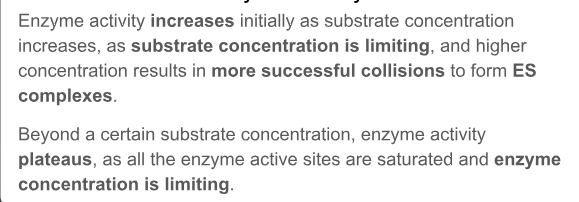
how is the effect of pH on enzyme activity investigated?

what is the effect of pH on enzyme activity?
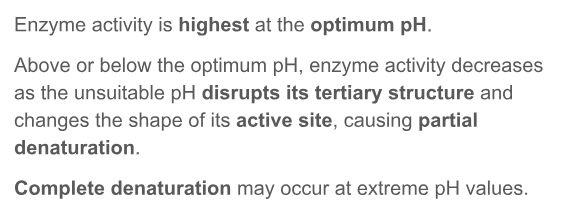
how is the effect of temperature on trypsin activity measured?

what is the effect of temperature on enzyme activity?

state a hazard and safety precaution involved in this practical
students may have allergic reactions to enzymes, so avoid contact with skin and eyes, wear protection
what is the function of a stage mircometer?
to calibrate an eyepiece graticule so that it can be used to make measurements
how is an eyepiece graticule calibrated?
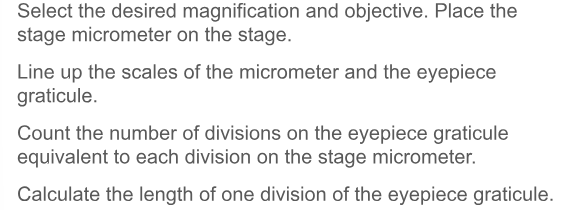
outline the procedure to preparing a slide
stain the sample with an appropriate dye
mount the sample on the slide
place a cover slip carefully on the slide, avoiding air bubbles
what is the formula for magnification?
size of image/actual size
what are the requirements for label lines in biological drawings?
must be horizontal straight (drawn with a ruler) and must not cross over the other lines
outline the procedure of focusing with a light microscope

where in plants can cells undergoing mitosis be found?
meristem tissue at shoot and root tips
what is the mitotic index?
ratio of cells undergoing mitosis to total no. of cells in a sample
outline the process to prepare a root tip slide
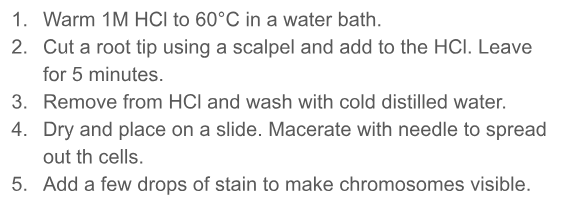
state the formula for the mitotic index
number of cells iwth visible chromosomes/number of cells in sample
state the hazards and precautions for reagents used in this procedure

why is the root tip placed in hot HCl?
dissolves the middle lamellae in order to break up the cellulose cell wall. allows the stain to permeate and the tip to be squashed more easily.
why is the sample squashed?
to flatten the sample and reduce the no. of layers, reducing overlap so the cells can be observed more clearly
what is the pollen tube?
it is a path through the stigma, made by the digestive enzymes, down which the pollen grain travels to reach the embryo sac, and hence fertilise the ovum
what structure controls the prodcution of these enzymes?
pollen tube nucleus
how is an eyepiece graticule calibrated to make measurements?
by using a stage micrometer
what are the controlled variables of this practical?

outline the procedure to the pollen tube growth practical
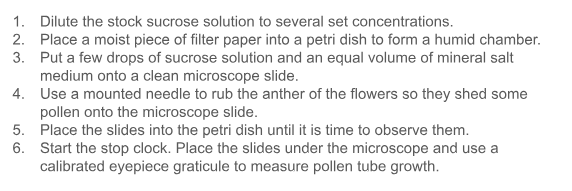
why should a cover slip not be used?
to allow oxygen to reach the pollen, preventing condiitons from being anoxic
state two factors that affect the permeability of cell membranes
temperature and the conc. of solvents (ethanol)
how is beetroot used to measure the permeability of cell membranes?

outline the procedure to investigate the effect of temperature on permeability of cell membrane
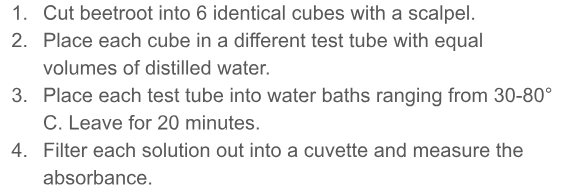
what are the safety hazards involved in testing the effect of ethanol concentration on membrane permeability?
ethanol is an irritant and is flammable, keep away from nakes flames, wear eye protection
keep sharp scalpel away from fingers
handle hot liquid with care
what is the effect of temperature on membrane permeability?
increasing temperature results in increased membrane permeability, as proteins in the membrane denature to produce gaps
what is the effect of ethanol concentration on membrane permeability?
increasing ethanol conc, leads to increased membrane permeability, as ethanol causes gaps to form in the membrane
what is plasmolysis?
where the protoplasm of the plant cell begins to shrink away from the cell wall
what is incipient plasmolysis?
where the water potential of the cytoplasm is the same as the solution
the point at which plasmolysis just begins to occur
why are the plant cells left in the mineral salt solution for twenty mins before observation?
to allow time for osmosis to reach eqm
outline the procedure to this practical

how should a diagram be drawn?
large diagram, using up at least half the space given. no shading with single continuous lines in pencil
what steps should be taken before viewing the locus under a microscope?
remove the exoskeleton and flood the specimen with water
what is the function of a potometer?
a device used to measure the rate of water uptake of a plant, and hence the rate of transpiration
which factors affect the rate of transpiration?
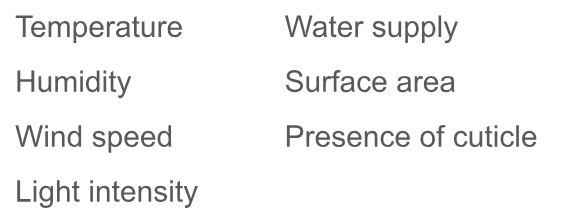
why must the leafy shoot be cut underwater?
to prevent air bubbles from forming the vascular tissue
outline the procedure to his practical

how is the rate of transpiration calculated?

how is light intensity controlled?
by changing the distance between the lamp and the potometer
how can wind speed be controlled?
by placing a fan near the potometer with different speeds
how can humidity be controlled?
by wrapping a plastic bag around the plant to maintain a humid environment
describe how a respirometer works
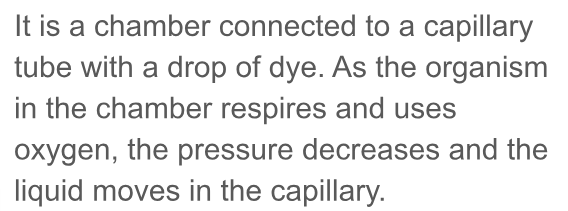
what is the control for this practical?
replace the organism with an inert object of the same mass
how do you find the volume of oxygen consumed using a respirometer?

how can the volume of carbon dioxide produced be found?

how is the rate of respiration calculated using data from the respirometer?
volume of oxygen used/mass/time
state the hazard and safety precaution involved in the practical
the soda lime is corrosive. wear protection and handle with gloves.
what are the controlled variables of this practical?

what are the types of pigments found in chloroplasts?
primary and accessory pigments
what is the purpose of having different accessory pigments?
to absorb a wider range of wavelengths of light
why is sodium hydrigen carbonated added?
to supply carbon dizoide for photosynthesis
what does the volume of gas produced indicate?
it is assumed to be oxygen, so the volume of gas is proportional to the rate of photosynthesis
what are the controlled variables of this practical?
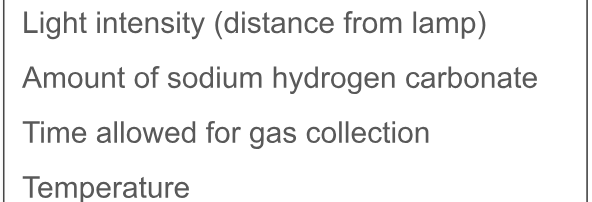
how is the light intensity controlled?
by using different coloured filters to cover one side of the beaker close to the lamp, and covering the other side using aluminium foil
outline the procedure to this practical
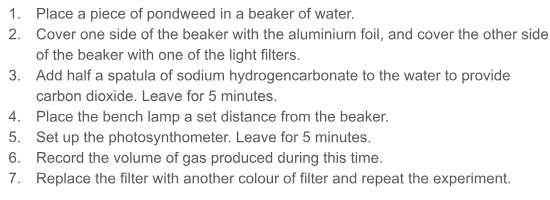
what is the purpose of chromatography?
to separate different components in a sample
state the factors affecting the rate of migration of different pigments
solubility, mass and affinity to the paper
what is the formula of the Rf value?
distance moved by pigment/distance moved by solvent
what is the purpose of finding the Rf value of a pigment?
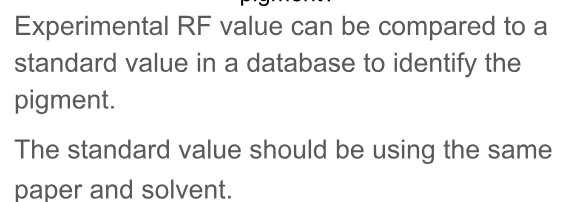
outline the procedure of using chromatography to separate photosynthetic pigments
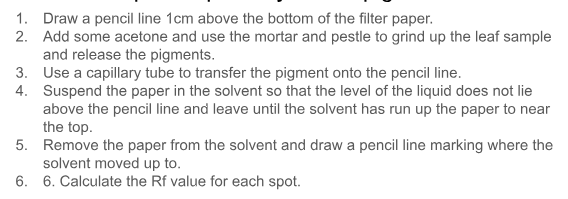
state the hazards and precautions in this practical
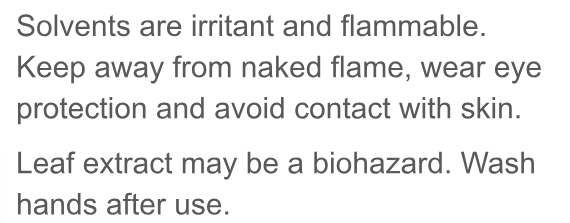
how can a colorimeter be used to measure the rate of growth of microorganisms?
as microorganisms increase in solution, the turbidness of the solution increases, less light passes through and absorbance increases
how is the growth rate of the microorganism measured?
transfer a sample from the microorganism culture to a cuvette at intervals, or use a datalogger to continuously record absorbance
as the age of the culture increases, how does the absorbance vary?
the absorbance increases to a maximum, then remains constant
how can a cell count be found?
stain the yeast suspension with a methylene blue and view in a haemocytometer to find the cell density. multiply cell density by total volume by cell count.
state the hazards and safety precautions involved in this practical
yeast may cause an allergic reaction. avoid contact with skin, use aseptic techniques.
state six aseptic techniques
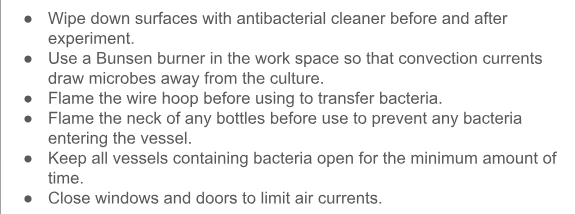
how can different colonies on an agar plate be distinguished from each other?
different colonies will have different sizes, colour and texture.
outline the procedure to isolating a particular species of bacteria

why should the lid of the petri dish not be fully taped around?
to allow oxygen to enter, preventing the conditions from becoming anoxic
what is the role of gibberellin during germination?
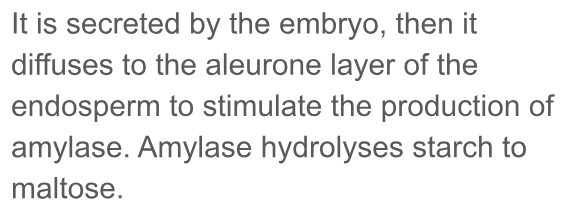
how is the effect of gibberellin concentration on amylase production investigated?

what does the zone of inhibition indicate?
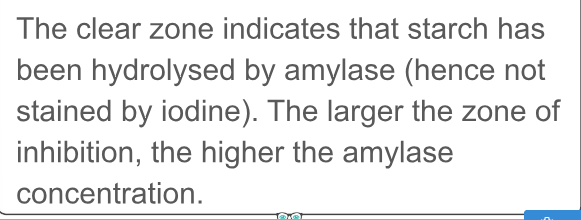
why are the seeds placed in sodium hypochlorite solution?
to sterilise the seeds
what is the ffect of gibberellin concentration on amylase production?
increasing gibberllin conc, increases the area of the clear zone, indicating an increased production of amylase and more starch hydrolysed
what are some sources of error in this practical?
the existing gibberellin and amylase content of the seeds may be different
whya re some controlled variables of the gibberellin practical?
time allowed to soak in gibberellin
time left on starch agar plate
source/age of seeds
what is the independent variable in the quadrat practical?
the sampling method using a frame or point quadrat or the quadrat size
how is percentage cover calculated?
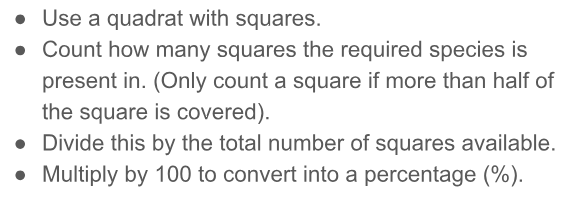
outline the procedure to this practical
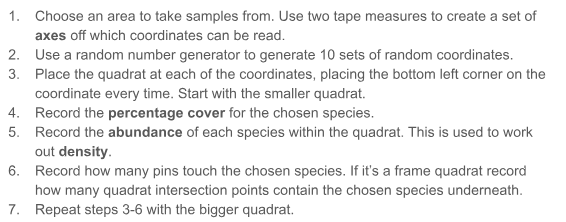
how can the results be used to determine if there is a difference betweent he percentage cover or density for each sampling method?
use a stats test e.g. t-test
what is an abiotic factor?
non-living or physical factor
list abiotic factors

how is percentage cover calculated?
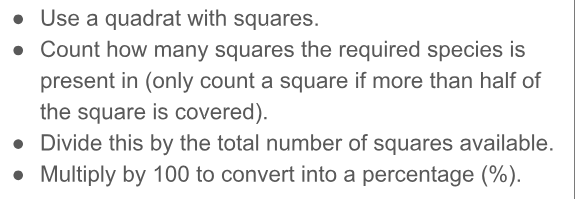
outline the procedure to this practical when finding the effect on distribution

describe an alternative way of measuring abundance
work out percentage cover BUT this is an estimate of abundance so it is less accurate
what is a null hypothesis?

how can the results be used to detemine the relationship between the chosen factor and the morphology of a species?

what is the difference between a risk and a hazard?
hazard describes the potential source of harm whereas risk describes the likelihood of the harm occurring